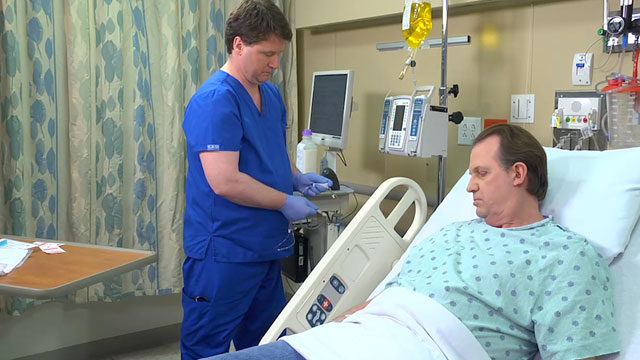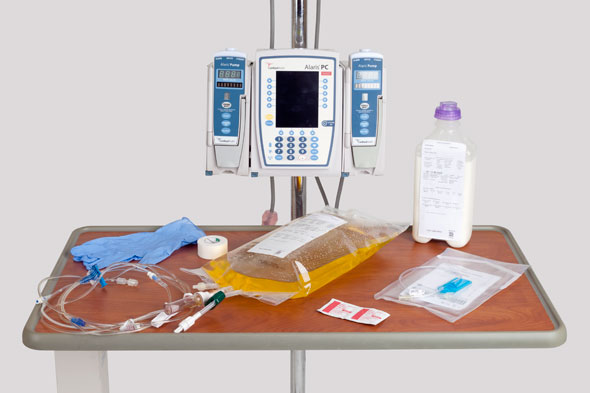Parenteral Nutrition
Select a Skill:
- » Administering Parenteral Nutrition Through a Central Line (CPN)
- » Administering PPN with Lipid Infusion
Take the Review Test:

Safety
- Change administration sets (including piggybacks) used for fat emulsions every 24 hours or immediately upon suspected contamination.
- To avoid phlebitis, change peripheral parenteral nutrition (PPN) access location frequently.
- Use caution when administering PPN to patients with impaired renal or cardiac function. Because of the lower concentration of dextrose in PPN, a larger volume of fluid is required to deliver adequate calories.
- Avoid infusing separate fat emulsions too rapidly. Infusion time is normally at least 8 hours. Do not hang separate fat emulsions longer than 12 hours.
- Avoid confusing an enteral tube feeding formula with parenteral lipids. Lipid emulsions are white and opaque.
- Allow refrigerated PPN solutions to sit for 1 hour at room temperature before using for an infusion.
- To administer a lipid emulsion, select an IV filter larger than 0.22 μm. Lipid particles cannot infuse through a smaller filter.
Equipment
(Roll cursor over items to see labels)

PPN solution
Lipid emulsion
IV tubing for PPN with 1.2-µm filter for amino acid/dextrose solution
Nonphthalate-vented IV tubing infusion set for fat emulsion
Antimicrobial swabs
Cloth Tape
Infusion pump (if not already in use)
Clean gloves
Delegation
The skill of administering peripheral parenteral nutrition (PPN) may not be delegated to nursing assistive personnel (NAP). Delegation of related skills varies by state Nurse Practice Act. Before delegating related skills, be sure to inform NAP of the following:
- Instruct NAP to report the following to you:
- Patient complains of burning, pain, or redness at peripheral IV site
- Pump alarm sounds
- IV site dressing is moist
- Instruct NAP to report to you any patient complaints of shortness of breath and any change in vital signs.
Preparation
- Assess the patient for hypertriglyceridemia. Obtain an order for a serum triglyceride level before initiating peripheral parenteral nutrition (PPN), and renew the order weekly per agency policy.
- Select or initiate an appropriate functional IV site using an 18-gauge catheter to administer PPN and lipid emulsion. Assess its patency and function.
- Check the health care provider’s orders against the MAR for the volume of fat emulsion, the PPN solution to be used, and the administration time for the fat emulsion.
- Read the label of the fat emulsion solution.
- Assess the patient’s blood glucose level by fingerstick.
- Assess the patient’s fluid status by monitoring for edema, shortness of breath, or fluid intake greater than fluid output.
- Obtain the patient’s weight and vital signs before beginning the infusion.
- If the PPN solution is refrigerated, remove it from refrigeration 1 hour before beginning the infusion.
Follow-up
- Monitor the flow rate hourly or more frequently if necessary.
- Measure the patient’s vital signs and general comfort level every 10 minutes for the first 30 minutes.
- Monitor the patient’s laboratory values such as triglycerides and liver function tests daily, and perform blood glucose monitoring as ordered. Measure the patient’s serum lipids 4 hours after discontinuing the infusion.
- Monitor the patient’s temperature every 4 hours, and regularly inspect the venipuncture site for signs of phlebitis or infiltration.
- Assess the patient’s weight, intake and output (I&O), condition of peripheral extremities (for edema), and breath sounds.
Documentation
- Record the condition of the IV site, the types of solutions used, the rate and status of the infusion, the catheter lumen used for the infusion, I&O every 8 hours, blood glucose levels, vital signs, weight measurements, and other assessment findings.
- Record any adverse reactions.
- If signs of fat intolerance, infection, occlusion, fluid retention, or infiltration occur, notify the health care provider.
Review Questions
1. Which action would the nurse perform to ensure patient safety during PPN and fat emulsion therapy?
 Change the tubing on the fat emulsion every 48 hours.
Change the tubing on the fat emulsion every 48 hours. Infuse the fat emulsion through a 0.22-μm IV filter.
Infuse the fat emulsion through a 0.22-μm IV filter. Plan to infuse the fat emulsion over 18 hours.
Plan to infuse the fat emulsion over 18 hours. Allow a refrigerated fat emulsion to sit at room temperature for 1 hour before infusing it.
Allow a refrigerated fat emulsion to sit at room temperature for 1 hour before infusing it.
2. Which instruction might the nurse give to nursing assistive personnel (NAP) caring for a patient receiving a fat emulsion?
 “Check the patient’s IV site for any signs of phlebitis.”
“Check the patient’s IV site for any signs of phlebitis.” “I will need to know the patient’s vital signs every 4 hours.”
“I will need to know the patient’s vital signs every 4 hours.” “Slow down the IV rate if the patient complains of pain at the insertion site.”
“Slow down the IV rate if the patient complains of pain at the insertion site.” “Be sure the patient understands the reason that the infusion has been ordered.”
“Be sure the patient understands the reason that the infusion has been ordered.”
3. Which nursing action is most important to ensure patient safety when infusing a fat emulsion?
 Perform hand hygiene before initiating any contact with the lipid solution.
Perform hand hygiene before initiating any contact with the lipid solution. Assess the patient every 10 minutes for 30 minutes after starting the infusion.
Assess the patient every 10 minutes for 30 minutes after starting the infusion. Change the infusion tubing with each administration.
Change the infusion tubing with each administration. Perform frequent inspection of the patient’s access site.
Perform frequent inspection of the patient’s access site.
4. A patient is prescribed to receive an infusion of 20% fat emulsion. The nurse informs the patient that this infusion will last how long?
5. What is the initial infusion rate for a 20% fat emulsion?
You have completed the Review Questions for this skill. To take the Review again select the Start Over button. To proceed to another skill select from the dropdown menu. Select the Home or Back button to proceed to the next section.


